Intel's Menlow Revealed: Baby Centrino Gets Ready
by Anand Lal Shimpi on January 9, 2008 12:00 AM EST- Posted in
- CPUs
As we wrote about at last year's IDF, Menlow is the name of this new ultra mobile platform that Intel is working on. In Intel's terms the platform refers to the CPU + chipset, much like how Centrino is a combination of an Intel CPU, Intel chipset and Intel wireless adapter.
The Menlow project began back in 2004, so what you're hearing about today is much like what Centrino was back in 2003. We're on the verge of something very big (I could insert a pun here about how Menlow is actually very small and it's ironic that it's also something very big, but I won't; you can thank me later).
Menlow consists of the Silverthorne processor and the Poulsbo chipset. If you're in dire need of yet another codename, the core used in Silverthorne is also known as Bonnenn.
Silverthorne is a brand new architecture, highly simplified from current Core 2 chips (thus reducing die size and power consumption) but still compatible. Silverthorne is an x86 chip, meaning it can run the same applications as your desktop and notebook; and it's technically ISA compatible with Merom (65nm Core 2 Duo), meaning it has support for up to SSE3 but lacks SSE4 instructions.
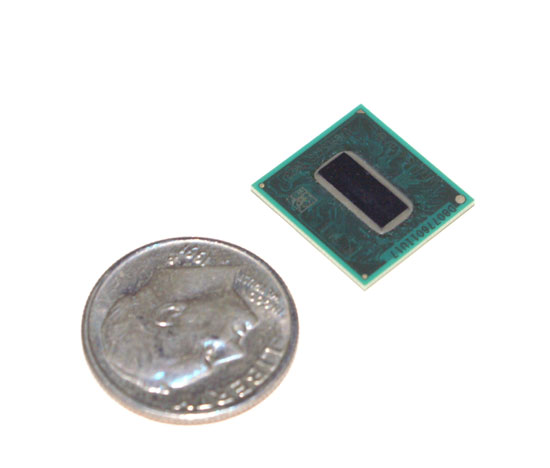
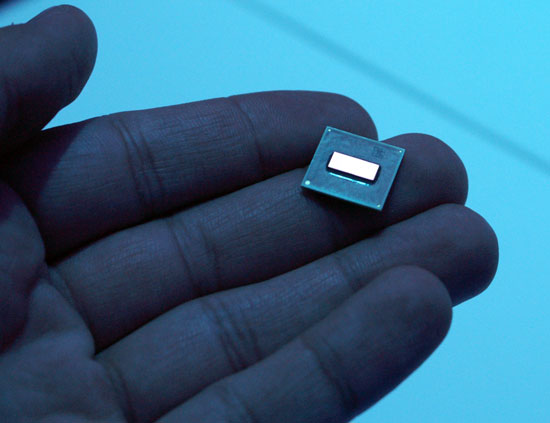
You can see the chip in the picture above; it's tiny. Because of its size you can guess that it's not a very complex core, and not full of cache, despite the obvious reductions in hardware Intel promises that Silverthorne will offer performance comparable to its 90nm Pentium-M from 2004.
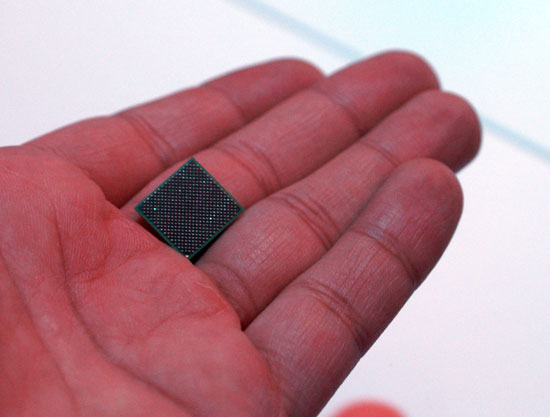
We asked for clarification on these performance expectations as this wasn't the first time we'd heard it from Intel. What we got was a promise that Silverthorne, at launch, will be available in clock speeds that the Pentium M was in 2004 and at comparable performance levels as well. Looking back at our original review of the 90nm Pentium M from 2004 we see that the chip launched at frequencies ranging from 1.0GHz up to 2.0GHz. Intel actually had Silverthorne running at its CES booth, at clock speeds ranging from 600MHz to 1.6GHz.
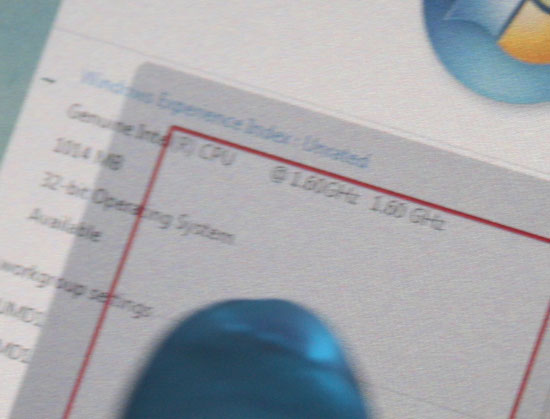
Intel is targeting 10x lower power than its current ultra low voltage processors, meaning a TDP of 0.55 - 0.6W. These TDPs will be possible at the low end of the clock speed spectrum, which so far means 600MHz. The higher clocked parts will obviously consume more power, but Intel says that it'll still be significantly less than 5.5W.
From a performance standpoint, Intel is shooting for Dothan (90nm Pentium M) level performance in a 5" form factor with Menlow/Silverthorne.
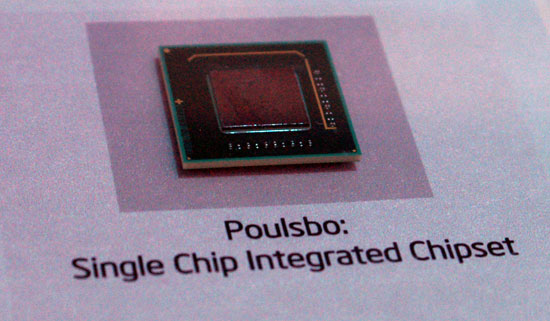
While Silverthorne is built on a 45nm process its chipset, Poulsbo, isn't. We couldn't get confirmation on the manufacturing process but we'd suspect that it's at least 65nm, resulting in a much larger die than the Silverthorne processor itself as you can see from the pics above.










22 Comments
View All Comments
babyyloth - Wednesday, July 14, 2021 - link
Though the natural cotton baby clothes trend is extremely popular with garb makers and shops, many dad and mom are careworn due to the fact they surely don't recognize how the time period natural pertains to cotton and baby clothes. Too, parents regularly accept as true with that the term is in reality made up to con them into believing https://lilpetites.comthere's some thing special about the infant clothes when there in all likelihood isn't always. Many of them will bypass on shopping for organic baby clothes, blankets, and such--and as a consequence miss the many advantages that their children could get from carrying them.
TA152H - Thursday, January 10, 2008 - link
Anand,Do you have any idea what this processor is in terms of the architecture? I still have not read anything about whether, for example, it's decoupled, it's superscalar, it's superpipeline, and if it is superscalar, is it out of order, etc ...
Is Intel just not releasing any of this information yet? I guess one clue is that they say it will run at the same clock speeds and performance level as the Pentium M did, so I guess it would almost have to be superscalar, and probably even out of order. But then, why make a new processor from scratch if it's almost the same as the Pentium M. It's kind of confusing. Maybe they reached the same goal by doing something different, that uses less power. For example, maybe it's a shorter pipelined beast, which would increase IPC and lower clock speed and make it smaller and less power hungry. Maybe it's not decoupled, which would save some stages, and some transistors.
I hope Intel will release more information on it. It's would be really interesting to see how they went with it. I'd like to see AMD release a K6 derivative as a mobile chip instead of something off the K7/K8 core. It might not reach the same clock speeds, but I think it had excellent power use characteristics and had relatively high IPC (especially the K6-III).
IntelUser2000 - Thursday, January 10, 2008 - link
ISSCC 2008 preview: "A 47M transistor, 25mm2, sub-2W IA processor designed for mobile internet devices…It features a 2-issue, in-order pipeline with 32KB iL1 and 24KB dL1 caches, integer and floating point execution units, x86 front end, a 512KB L2 cache and a 533MT/s front-side bus. The design is manufactured in 9M 45nm High-k metal-gate CMOS and housed in a 441-ball µFCBGA package."VLSI Seminar(http://dropzone.tamu.edu/VLSISeminars)">http://dropzone.tamu.edu/VLSISeminars): "This presentation will describe a low power Intel(r) Architecture (IA) processor specifically designed for Ultra-Mobile PCs where average power consumed is in the order of a few hundred mW with performance similar to mainstream Ultra-Mobile PCs. The design consists of an in-order pipeline capable of issuing 2 instructions per cycle supporting 2 threads, 32KB instruction and 24KB data L1 caches, independent integer and floating point execution units, x86 front end execution unit, a 512KB L2 cache and a 533 MT/s dual-mode (GTL and CMOS) front-side-bus (FSB). The design contains 47M transistors in a die size under 25 mm2 manufactured in a 9-metal 45nm CMOS process with optimized transistors for low leakage packaged in a Halide-Free 441 ball, 14X13 mm uFCBGA. Thermal Design Power (TDP) consumption is measured at 2W using a synthetic power-virus test at a frequency of 2GHz."
Unlikely it'll be Pentium M range. It's supposed to have Hyper-threading and talks about high throughput oriented processor. The CPU performance is something like 800MHz Dothan-512 at single thread and 40-50% faster with multi-thread, and that's when its clocked at 1.8GHz.
TA152H - Friday, January 11, 2008 - link
Thanks for the information.I agree, it will be impossible for it to have the same IPC capability as the Pentium M. I'm not sure why Intel is saying that. It does look a little more formidable than the VIA chips though. It will be interesting to see what VIA does to counter them.
It's kind of interesting how the computer industry constantly goes in circles. The CGA and MDA adapters (and later EGA) were digital output, VGA and later were analog, now we're back to digital. Superscalar processors, particularly the Pentium, were in order, then went out of order, and now we're seeing the POWER, Itanium and this chip going back to being in order. Before it was the processor that did the video processing, and the cards were just dumb frame buffers. Now, they are talking about moving the video processor back into the CPU.
I just hope the cassette tape doesn't come back as a means of storage. CLOAD. Ugggh!
IntelUser2000 - Thursday, January 10, 2008 - link
Anyways, it'll be an upgrade for the UMPCs anyway with its greater multi-threading performance(somewhat possible single thread??) over the current A110 CPU that's used on the UMPCs.I don't get Moorestown though, why push x86 on non-Windows platform?? WTF Intel!!
Cali3350 - Wednesday, January 9, 2008 - link
Considering how much we've been hearing about this platform for the last year or so i must say it does seem rather disappointing. I was led to believe this would the next wave of real portable devices, something Apple and the like would adopt willingly very early. I must say i don't see that occurring from this article.Ofcourse this is just a quick article from CES, maybe things are different when you really get up close and personal with it.
hnhunt66 - Wednesday, January 9, 2008 - link
the eventual migration of many of these features like web browsing and the like to devices other than the main number cruncher in the house (the pc or mac) has been a couple of years away for about a decade. The cost effectiveness of reusing code across multiple platforms is the main reason that Intel is more than likely on a good path here. The technically inclined and those young enough for this to be natural still like the cheep sometimes at the expense of elegance. The rest of the world just wants it to be plug and play this is achieved at low costs by not having to write new code or debug recompiles for every device. Under estimating the value of the x86 architecture is risky at best, I was reading about its demise in the 80's.Freddo - Wednesday, January 9, 2008 - link
I would love to see a Menlow notebook (not UMPC). Something like the Eee PC from ASUS, but with some noticeably changes.Bluetooth support is a must. HDMI would be very nice too, so you can hook it into the TV for a larger screen now and then. Maybe even use it as a HTPC with an external optic drive thru the USB.
It would be a perfect nice little energy-efficient notebook :)
psychobriggsy - Wednesday, January 9, 2008 - link
Intel tries to catch up to where ARM has been for years. The iPhone chip has the CPU, GPU, RAM, and loads more just on the CPU package (about the size of Silverthorne). Apple won't take over markets by waiting 3 years to get where they can be with ARM today.Intel are hoping for 2x the iPhone processing power ... a year after the iPhone came out. And that's using a 620MHz ARM11 based core. If Intel do try, Samsung will come out with an ARM Cortex multi-core fully integrated 3G phone on a single piece of silicon with RAM and flash stacked into just the space of the Intel CPU.
Look at the iPhone motherboard. There's no contest as to which architecture is going to get picked. Even in 2010 Intel will have 3 large (for a phone) chips - CPU, I/O and RAM, and that's before you get any phone related circuitry and storage.
Apple are perfectly happy with using ARM in their iPods and iPhones. They've got 15 years of ARM experience in-house. ARM are actually really making moves in terms of performance now as well, with the Cortex cores.
Now on the upside for Intel, these will be very neat systems and I expect that small media servers and the like will abound. Shame that they have such a fixation on mobile internet that the real opportunities could pass them by. All those MIDs look crap. The article says that even with 2x the power of the iPhone the interfaces are sluggish (yet are still way faster and better than Vista) ... there's no hope.
defter - Thursday, January 10, 2008 - link
[quote]Apple won't take over markets by waiting 3 years to get where they can be with ARM today.[/quote]Actually I don't understand why Apple has been mentioned something like 10 times in the article and many times in comments. They have maybe 4-6% of share in a smartphone market and 1-2% share in a whole cell phone market, what they do or not do isn't important.
Of course cell phone manufacturers will not "wait" for Intel CPU and will continue to use ARM based CPUs in the near future, it would be silly to expect otherwise. It seems that currently, Menlow would be very suitable for EEE PC type of devices: it's cheap, has a low power consumption and takes a very little of space compared to current mobile CPUs.
Then maybe in 3-4 years Menlow successors could be good enough for cell phone integrations. Remember: Intel has a lot of money and has a manufacturing process advantage, especially the latter is very important for power consumption. In the distant future we could see 22nm Menlow's successor competing against 32nm ARM CPUs, in that case ARM's power consumption advantage is not given...